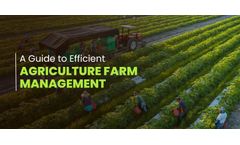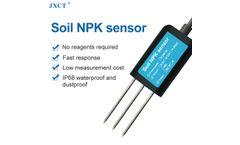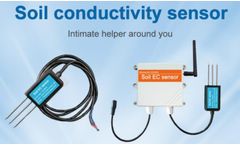Refine by
Fertilizer Application Articles & Analysis
158 articles found
. #1s by 27 cwt/acre and overall yield by 31 cwt/acre. Application: 1 gallon per acre of Enhance foliar applied at tuber initiation, on July 13th, and again on August 7th. Fertilizer Application: 350 lb./A 18-46-00 and 100 lb./A of Calcium sulfate applied through the planter, 30 ...
Our innovation is a major transformation in farmers’ decision making regarding the application of limited resources such as water, seeds, fertilizer and labor. ...
Agriculture has always been a fundamental part of human civilization, providing the food and resources necessary for survival. However, as the global population continues to rise and climate change presents new challenges, the need for efficient agriculture farm management has become increasingly critical. Implementing modern technologies and innovative practices can help optimize productivity, ...
Nutrient Management: Accurate measurements of nutrient levels in the soil help farmers apply fertilizers more efficiently, minimizing environmental impact and reducing input costs. ...
ByJXCT
This article explores the benefits and applications of leveraging soil sensors for enhanced soil management in modern agriculture. ...
ByJXCT
Monitoring soil health is essential for farmers to make informed decisions about crop management practices, fertilizer application, and irrigation strategies. In recent years, advanced soil sensor systems have revolutionized the way we monitor and assess soil health parameters. ...
ByJXCT
Avoid excess crop nutrients in your fertilizer strategy to maintain soil health and protect your pocketbook The push to produce higher yields per acre every year continues to weigh heavily on western Canadian farmers. ...
Identify and correct crop nutrient deficiencies in your soil to increase yield and profit Achieving prosperity in Canadian agriculture is a balancing act. While new technologies increasingly grow your potential to overcome limiting factors and boost yields, oftentimes revisiting the basics will further support your efforts to reach an optimum balance in soil nutrients. A great place to start is ...
During drought or dry conditions, salinity and pH levels can change quickly in the soil. While the forecast shouldn’t entirely dictate how you manage your farm, understanding and performing the best farming practices when adding seed-placed nutrients can help save your yields when the rain fails to ...
When it comes to applying seed-placed fertilizer, it is important to find the suitable application rate for each specific soil type and composition. ...
Here are some of the ways that portable soil EC detectors can help agricultural management: Monitoring Soil Fertility: Soil fertility is a crucial factor in crop growth and yield. Portable soil EC detectors can help farmers identify areas of the field with low fertility, allowing them to target fertilizer ...
ByJXCT
EC, measured in deciSiemens per meter (dS/m), reflects the amount of salt and other dissolved minerals in the soil solution. It's a crucial indicator of fertility, drainage, and irrigation efficiency. High EC, for instance, might signal excessive salinity, hindering nutrient uptake and plant growth. ...
By analyzing data on nutrient levels in the soil, farmers can: Identify nutrient deficiencies: Quickly identify areas with specific nutrient deficiencies, allowing for targeted fertilization applications. Optimize nutrient use: Apply only the necessary amount of fertilizer, maximizing efficiency and minimizing environmental impact. Reduce ...
Benefits of Soil NPK Sensors The adoption of soil NPK sensors offers a multitude of benefits to farmers, including: Precision Nutrient Application: By pinpointing nutrient deficiencies and excesses, farmers can precisely apply fertilizers, minimizing the risk of over- or under-application and reducing nutrient runoff and environmental impact. ...
This granular information empowers farmers to make informed decisions regarding irrigation, fertilization, and crop management, optimizing resource utilization and maximizing yields. ...
Introduction Plant nutrition is a critical aspect of sustainable agriculture, as it directly impacts the growth, development, and yield of crops. Traditional methods of fertilizer application often lead to over- or under-fertilization, resulting in poor plant growth or environmental pollution. ...
ByJXCT
Agriculture is a crucial sector that provides food for the world's population. As the population continues to grow, the demand for food also increases. To meet this demand, farmers must produce more food with fewer resources. One of the ways to achieve this is by optimizing crop nutrition and maximizing yield. Soil NPK sensors have emerged as a useful tool for farmers to achieve these goals. Soil ...
Agriculture is a crucial sector that provides food for the world's population. As the population continues to grow, the demand for food also increases. To meet this demand, farmers must produce more food with fewer resources. One of the ways to achieve this is by optimizing crop nutrition and maximizing yield. Soil NPK sensors have emerged as a useful tool for farmers to achieve these goals. Soil ...
By understanding the relationship between soil salinity and nutrient levels, farmers can optimize their fertilizer application strategies, ensuring that crops receive the right amount of nutrients for optimal growth and yield. c. ...
Most farmers can agree that although there’s no silver bullet to a bumper crop, healthy soil plays a crucial role, from seeding to harvest and beyond. But how much is understood about what really happens beneath the surface of the field? “Well-functioning soil will retain, provide and recycle nutrients and water, and will support a diverse array of biota in the soil-plant ...









